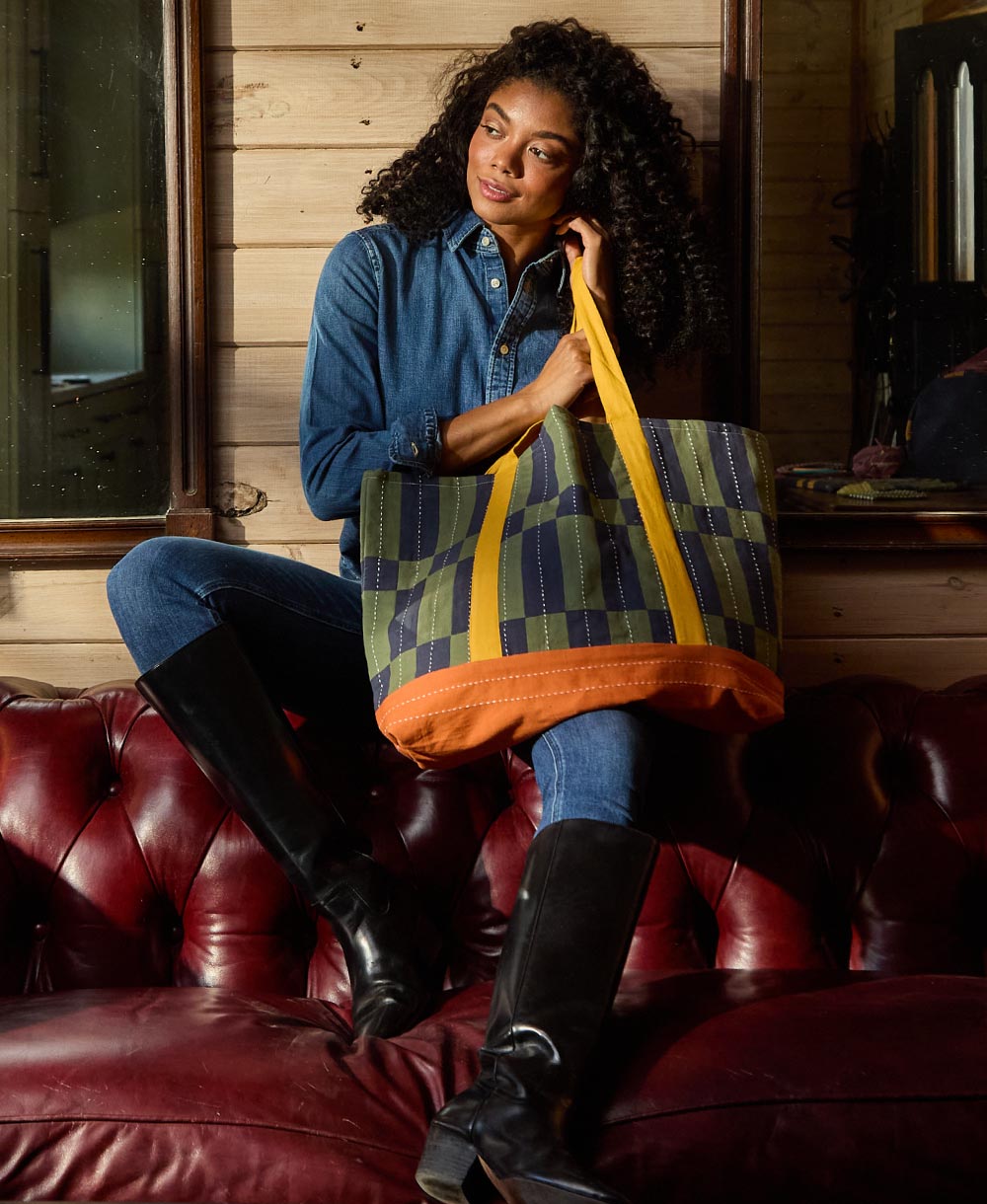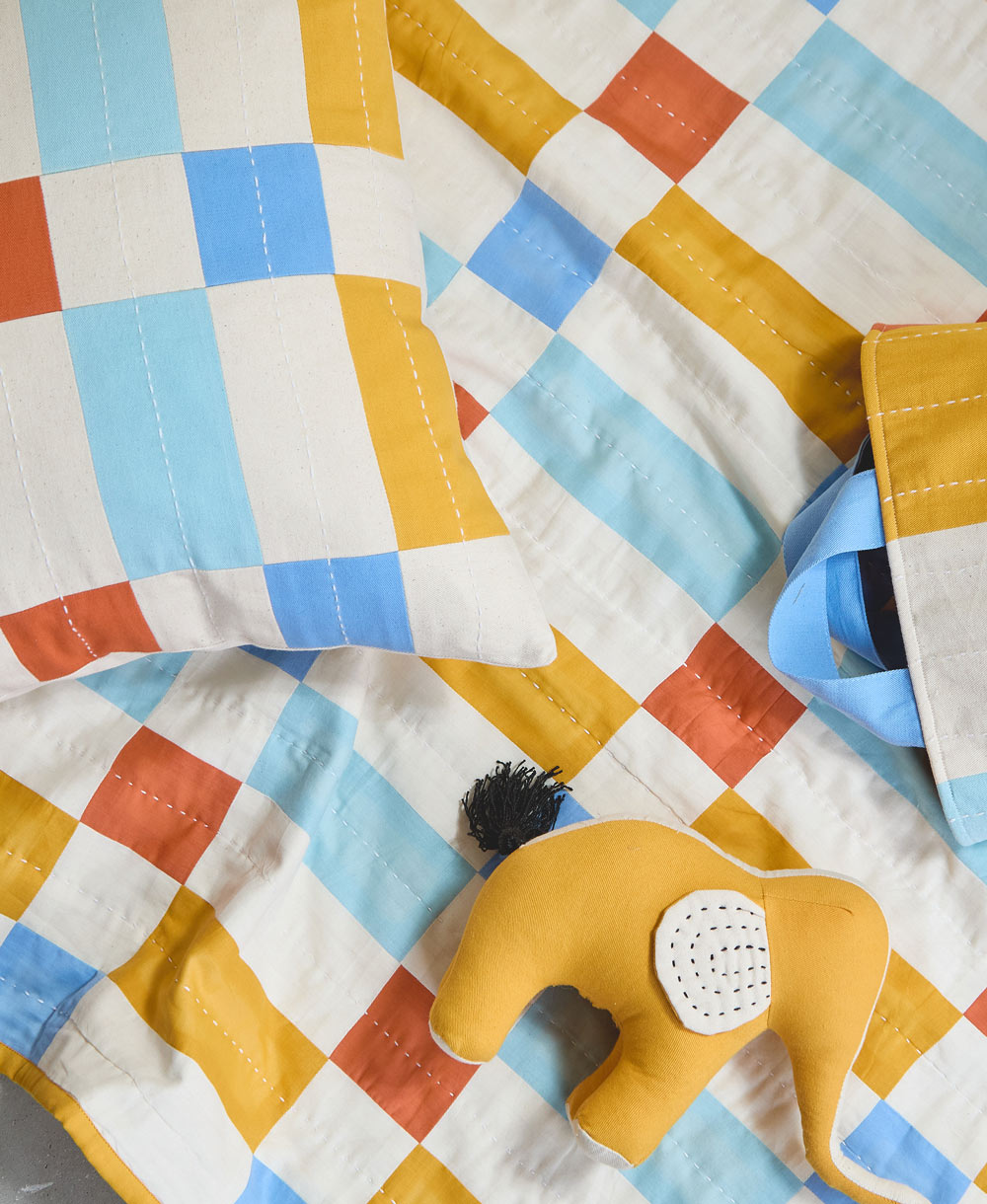Our newest collection highlights bright colors found in plants through an assortment of color-block pillows and bandanas. Anchal's dyeScape Coordinator, Brent Drew-Wolak, shares the inspiration behind the our newest Naturally Dyed Collection and what we can expect next from Anchal's dyeScape garden.
This new collection is full of bold color. What was the initial inspiration behind the collection? How do you choose the colors for the pieces?
This collection was inspired by color. We love the boldness of natural color and wanted to create a collection that embraced the rich depth that can be achieved with natural dyes. We were excited by the variation in shades that come from a single dye bath. The colors in this collection were all created from single color dye baths and the panels of the pillows shift in shade depending on how long the fabric was left in the dye. We loved this natural variation and are excited to showcase it in this collection.

Where does the production take place and where do the materials for the collection come from?
The entire dyeScape collection is produced in our studio in Louisville, Kentucky. We take pride in the fact that our entire production process from seed to end product takes place within a two mile radius. We grow five different kinds of dye plants in our urban garden that gives us the raw materials needed to make our dye baths. Once the plants are fully grown, they are either used fresh or brought back to our studio to be dried and stored for future projects.
Cochineal is one of the only dyes that we use that does not grow in Kentucky. Cochineal is the most commonly used insect dye and it produces vibrant shades of fuchsia, red, and purple. The bugs typically live on the prickly pear cactus native to Mexico, Central and South America. We source whole, dried Cochineal from a natural dye company in Seattle.
When dyeing with natural materials, you have to use natural fabrics. We source 100% cotton and 100% linen fabrics that help bring out the boldness of our dyes. All of our fabric is dyed by hand and then constructed into its final form by one of our three seamstresses. The whole dyeScape collection is special to our team in Kentucky because there is no part of the production that we don’t touch.


Can you describe the production process from harvest to final product?
We start all of our own seeds indoors in our Louisville, KY studio and then transplant them into the raised beds in our urban garden in the spring. Our growing season is from May-October. Each dye plant has a specific time during that period where it is harvested and brought back to our studio to be dried and stored for production. During most of the summer months we have piles of marigolds drying on tables all around our work space.
There are various extraction methods used to render the dye depending on what plant we are using - most involve a cooking process. Once the bath has been created, we dye each piece of fabric by hand.
After the fabric has been dyed, it is constructed into its final form in our studio by one of our three seamstresses. This labor intensive production process is why our dyeScape collections are small batch and limited. When we run out of dye materials, we aren’t able to produce any more products until the next harvest season.
What is a mordant and why is it important? Do all natural dyes need a mordant?
A mordant is a fixative that adheres natural dye to fabric. Mordanting is a crucial step in the dyeing process and is not optional. The only natural dye that does not require a mordant is Indigo. For all other natural dyes, mordanting is the base layer and first step in the dyeing process. Mordanting well leads to evenly dyed, colorfast fabric. It helps to ensure the most durable and long-lasting colors. It also helps make the colors bolder and more vibrant. There are many mordants available and there is some variation in which ones we use depend upon the type of fabric being dyed. We typically use Alum to mordnat cotton or linen.

What are some of the challenges of working with natural dyes?
Although natural dyes can produce a wide variety of colors, it can be hard to achieve consistency between dye baths. There are many variables that can change the color of the dye, so there will typically be subtle differences in color between pieces. In the end, it is all part of the nature of natural dyes.


How did Anchal's journey towards natural dyes begin? Where did the idea of dyeScape come from?
After seeing the impact that Anchal makes in Ajmer, India, Colleen, Anchal's founder and CEO, wanted to bring that social enterprise model to her hometown. With a background in landscape architecture and a love for plants, Colleen and her sister, Creative Director and COO, Maggie Clines, put together a proposal for a competition hosted by Louisville Metro Government and won the LOTS of Possibilities Award in May of 2014. The award helped them achieve their vision of providing an income stream for participants, enhance ecological balance, strengthen the local economy, and educate the community about sustainable textile practices. The grant awarded them with three parcels of land and the funds to construct ten raised beds, a tool shed, a trellis and a main water line for watering.
Personally, how did you become interested in natural dyeing?
I got interested in natural dyes while in college. I was studying fashion in Chicago and became disillusioned with the industry as a whole. I quickly shifted my focus to finding ways to slow down the fashion cycle and invest in sustainable textile practices. I learned about natural dyes while taking an elective course and fell in love with the process and the colors that you are able to achieve from plants. I haven’t looked back since! I am deeply committed to sustainable textile production and was amazed when I found Anchal. I love working for a company that is committed to transparency and low impact textile production.

What is growing in the dyeScape garden this season and what products can we expect from the next harvest?
We focus on growing five plants which produce the colors for most of our dyeScape products. We grow Indigo (blue), Madder (red), Marigold (orange/yellow/green), Goldenrod (yellow) and Hollyhock (blue/purple).
This summer, we are focusing heavily on growing Marigolds which are one of the easiest dye plants to grow and yield beautiful gold, green and orange hues. We are in our second season of growing Hollyhocks and are looking forward to incorporating the beautiful blues and purples into future designs.
As far as products go, you can expect to see us branch out into small batch apparel as well as table linens - all naturally dyed with plants and flowers grown right here in Louisville, KY.
We would also love to get our community more involved through dye workshops post-pandemic!


What is the best advice you have for people that are interested in natural dyes and would like to experiment with natural dyes at home? Where do you start? What are good plants and flowers to start with?
Dyeing is a lot like cooking and can easily be done at home! I think Indigo is a great place for people to start experimenting with natural dyes. It is such a fun dye to work with and kits are available at most craft stores or can easily be found online. All you need is some cotton or linen fabric and you’re good to go! I enjoy up-cycling old white clothing by dyeing them with Indigo. You can create fun resist patterns and make the pieces your own.
Another great way to get started with natural dyes is to grow a few Marigold plants. Marigolds are easily found at local garden supply stores, and they are low maintenance to grow. They also have a long growing season, so you should be able to get multiple dye baths from a few plants. Just pick the flowers when they’re in full bloom, lay them out to dry, and then you have the flowers to proceed to dyeing. There are many articles on how to dye with marigolds online. Just remember to use natural fabrics and don’t forget to mordant!
If you don't have a green thumb, a lot of the dye plants we use in our designs are native to Kentucky and can be foraged for dyeing. Some great examples include Goldenrod, Yarrow, and Osage. If you live in Louisville, Hays Kennedy Park has large fields of Goldenrod that bloom in August!
You can show your support by shopping the new Naturally Dyed Collection or consider making a direct donation to help expand our program.






